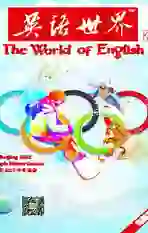Interesting Mascots 好玩的吉祥物
2021-01-12陈天怡
陈天怡
The Olympic mascots are fictional characters, usually an animal native to the area or human figures, who represent the cultural heritage of the place where the Olympic and Paralympic Games are taking place. The mascots are often used to help market the Olympic Games to a younger audience, in particular toddlers and children.
[2] Ever since the 1968 Winter Olympics in Grenoble, France, the Olympic Games have always had a mascot. Starting with the 2010 Vancouver mascots, the Olympic and Paralympic mascots have been presented together.
[3] The success of mascots helped the idea of a mascot become a symbol of the Olympic Games and developed into an institution. Mascots are very popular and despite the importance of the message they convey, they are designed in simple manner with bright, happy colors appropriate for the “festive” atmosphere of the Olympic Games.
[4] Now let’s look at some representative and interesting Olympic mascots:
[5] Haakon and Kristin are the mascots at the Lillehammer Olympic Winter Games in 1994. The mascots’ names refer to historical figures from the 13th century whose destiny is closely linked to Norway and the Lillehammer region, King of Norway from 1217 to 1263, and Princess Kristin, his aunt.
[6] The first mascots in human form, Haakon and Kristin are two happy children. Although they wear medieval clothes in reference to1 their historical roots, they are modern children and express the interests and visions of young people, such as environmental awareness.
[7] Owls Sukki, Nokki, Lekki and Tsukki are the mascots at the Nagano Olympic Winter Games in 1998. They are also known as the Snowlets. “Snow” recalls the winter season, during which the Games take place, and “lets” refers to “let’s”, and invitation to join in the Games celebrations. In addition, the first two letters of the four names form the word “snowlets”. “Owlets” means young owls.
[8] The four owls represent respec-tively fire (Sukki), air (Nokki), earth (Lekki) and water (Tsukki). The choice of four mascots is a nod to the four years that make up an Olympiad. Owls are venerated around the world as having the “wisdom of the woods”; in Greek mythology, the owl is associated with Athena, the goddess of wisdom.
[9] Powder, Copper and Coal are the mascots at the Salt Lake City Olympic Winter Games in 2002. The names Powder, Copper and Coal are an allusion to Utah’s natural resources, its snow and its land. Powder is a snowshoe hare, Copper a coyote and Coal a black bear. The hare’s speed, the coyote’s ability to climb the highest mountaintops and the black bear’s strength illustrate the Olympic motto Citius, Altius, Fortius2 (faster, higher, stronger). The inspiration for the mascots came from ancient Utah cultures. Each wears a necklace featuring the animal he/she represents in the form of a petroglyph (rock engraving) in the style of the Anasazis or Fremonts, ancient peoples from the region. In addition, the three animals were often the major protagonists in Native American legends, passed on from generation to generation.
[10] The two mascots are humanized snowball and ice cube at the Turin Olympic Winter Games in 2006. In Italian, “neve” means snow and “gliz” means ice. Together, they represent the fundamental elements required for successful Winter Games and personify winter sports. Neve, with fluid and rounded contours, is linked to harmony and elegance of movement. She is dressed in red. The angular and smooth shapes of Gliz recall the power and strength of athletes. He wears a blue outfit.
[11] Quatchi and Miga are the mascots at the Vancouver Olympic Winter Games in 2010.They are creatures inspired by the fauna and tales of the First Nations3 on the West Coast of Canada. Quatchi is a sasquatch, a popular character from local legend who lives in the forest. He is covered in thick fur and wears boots and earmuffs. Miga is a sea bear, a mythical animal that is part killer whale and part Kermode bear. The Kermode bear, also called “Bear Spirit”, lives only in British Columbia.
[12] The mascots of the PyeongChang 2018 Olympic Winter Games are Soohorang and Bandabi. Soohorang4 took its motif5 from the white tiger which has been long considered as Korea’s guardian animal. Soohorang not only has a challenging spirit and passion, but is also a trustworthy friend who protects the athletes, spectators and all the participants of the Olympic Games.
[13] Bandabi6 is an Asiatic black bear. The bear is symbolic of strong will and courage.
奧林匹克吉祥物是虚构的形象,往往要么是奥运会或残奥会举办地特有的动物,要么是人物形象,可以代表当地的文化传统。吉祥物有助于向低龄观众宣传奥运会,特别是少年儿童。
[2]自1968年在法国格勒诺布尔举办的冬季奥运会起,每一届奥运会都有一个吉祥物。从2010年温哥华吉祥物开始,奥运会和残奥会的吉祥物总是一同亮相。
[3]吉祥物的成功使其成为了奥林匹克的象征之一,并发展为一大惯例。吉祥物广受喜爱,虽然肩负传递重要信息的职责,却也凭借其简洁的造型和明快的色调,完美烘托了奥运会的“节庆”氛围。
[4]下面,让我们一起来看几组富有代表性而又妙趣横生的奥运吉祥物吧:
[5]哈康和克里斯汀是1994年利勒哈默尔冬奥会的吉祥物。他们的名字取自13世纪的历史人物——1217至1263年间统治挪威的国王以及他的姑妈克里斯汀公主,两人的命运与挪威及利勒哈默尔地区息息相关。
[6]哈康和克里斯汀是首对被赋予人形的吉祥物,外表为两个快乐的儿童。他们身穿中世纪服饰,以示其历史渊源,又和当代的孩子一样,展现出年轻人的兴趣和理想,比如环保意识。
[7] 1998年长野冬奥会的吉祥物是名为思崽、闹崽、赖崽和赐崽的四只猫头鹰,合称为雪精灵。其中,snow(雪)令人联想到冬季,即奥运会举办的季节;lets则与let’s(来吧)同音,广邀大众共庆奥运。四个名字的前两个字母合在一起就构成了snowlets一词,词的后半段owlets还有小猫头鹰之意。
[8]四只猫头鹰分别象征火、风、土和水,数目四契合冬奥会四年举办一次的周期。猫头鹰作为“森林的智者”,受到全世界的尊敬;希腊神话中猫头鹰让人联想到智慧女神雅典娜。
[9]鲍德、卡普尔和克尔是2002年盐湖城冬奥会的吉祥物。他们的名字喻指犹他州的自然资源、积雪和土地。鲍德是一只雪靴兔,卡普尔是一匹草原狼,克尔是一头黑熊。野兔的速度,草原狼攀爬高峰的能力,黑熊的力量,展现了“更快、更高、更强”的奥林匹克格言。吉祥物的灵感来自古犹他文化。每个吉祥物都戴有形状为其对应动物的岩雕项链,雕刻风格源自当地的古老民族——阿纳萨齐族和佛利蒙族。此外,这三种动物还常作为主角,出现在印第安代代相传的传说中。
[10] 2006年都灵冬奥会的两个吉祥物分别是人形的雪球和冰块。意大利语的“内苇”是雪的意思,“格利兹”则是冰的意思。他们代表着冬奥会成功举办必不可少的两大要素,同时也是冬季运动的化身。身着红衣的内苇轮廓流畅圆滑,体现了动作的和谐与优雅。蓝衫加身的格利兹外形规整光滑,令人联想到运动员的力量和强韧。
[11]魁特奇和米加是2010年温哥华冬奥会的吉祥物。他们脱胎于加拿大西海岸第一民族的动物和故事。魁特奇是个大脚野人,在当地传说中颇受欢迎,住在森林之中。他浑身覆盖着厚厚的毛发,脚踩长靴,头戴耳罩。米加是只海熊,神话中半虎鲸半克莫德熊的动物。克莫德熊也称“灵熊”,仅栖息于不列颠哥伦比亚省。
[12] 2018年平昌冬奥会的吉祥物是守护虎和半月熊。守护虎的形象取自白虎,后者素来被视为韩国的守护兽。守护虎不仅具有挑战精神和无限热情,更是守护运动员、观众和所有奥运参与者的可靠伙伴。
[13]半月熊是一只亚洲黑熊,象征强大的意志和勇气。□
